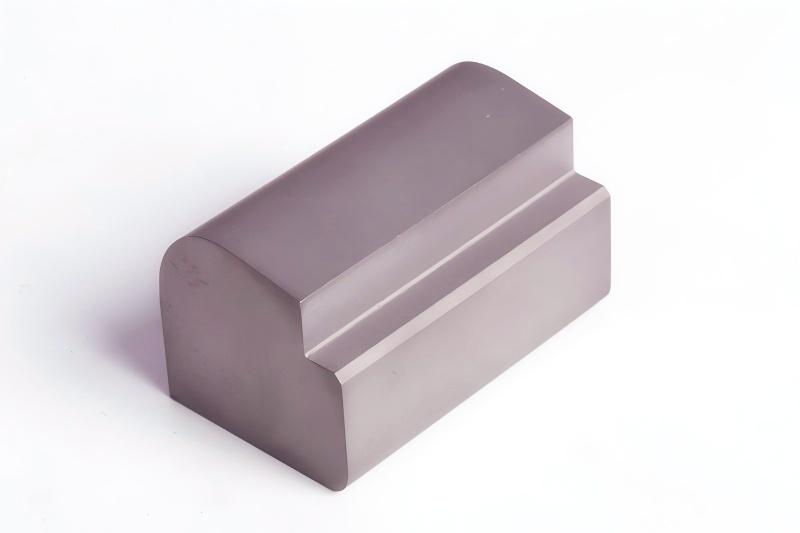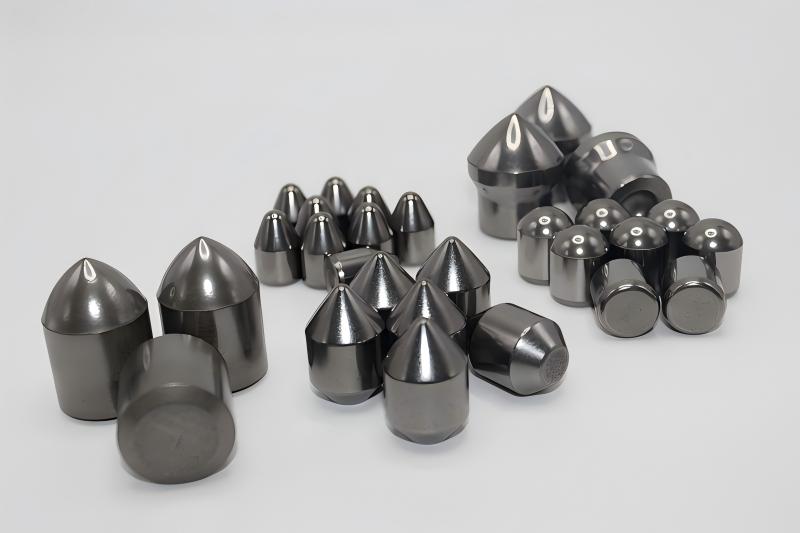Tungsten carbide compressive strength and tensile yield strength
Tungsten carbide forms a densely sintered crystalline structure through high-temperature bonding of tungsten and carbon atoms, endowing the material with exceptional hardness. As a ceramic material, pure tungsten carbide exhibits high hardness and brittleness, with relatively low tensile strength significantly influenced by manufacturing processes (e.g., sintering density, grain size). Pure tungsten carbide has a tensile strength of 344 MPa. Industrial-grade tungsten carbide is typically combined with binder metals such as cobalt (Co) and nickel (Ni) to bond the tungsten carbide particles, substantially improving brittleness and enhancing tensile strength. This composite material is commonly termed cemented carbide. Cemented tungsten carbides compressive strengths generally demonstrate ranging from 4,000 to 6,000 MPa (580,151–870,226 psi), equivalent to withstanding 400–600 kilograms per square millimeter. The table below presents the cemented tungsten carbide tensile and yield strengths for specific grades:
| Cemented carbide | Grade | Chemical composition | Tensile strength(MPa) | Yield strength(MPa) |
| WC-Co Low cobalt | YG6 | WC-6%Co | 1400~1800 | 1500~1800 |
| WC-Co Middle cobalt | YG8 | WC-8%Co | 1800~2200 | 1600~2000 |
| WC-Co High cobalt | YG15 | WC-15%Co | 2400~2800 | 1200~1500 |
| Ultrafine grain size WC-Co | YG10X | Ultrafine grain size WC-10% Co | 3000~3500 | 2000~2500 |
| WC-TiC-Co | YT15 | WC-15%TiC-6%Co | 1100~1500 | 1000~1300 |
| WC-Ni-Fe | YN10 | WC-10%Ni-5%Fe | 1600~2000 | 1400~1700 |
Cemented tungsten carbide tensile yield strength reflects the material’s ability to resist fracture under tension. During testing, the specimen ends are clamped in a tensile testing machine. As the pulling force increases, the transition point where the material shifts from elastic deformation to plastic deformation is the tensile yield strength. Due to the significant brittleness of cemented carbides, the tensile yield strength of tungsten carbide is markedly lower than its compressive strength, typically ranging from 1000 to 1500 MPa. This characteristic necessitates special attention to avoiding tensile stress concentrations when designing tungsten carbide components, such as employing rounded transitions at cutting tool edges.

The material composition ratio directly influences mechanical properties. For every 1% increase in cobalt content as the binder phase, the compressive strength decreases by approximately 80 MPa, but toughness improves. For example, a specific model of mining rock drilling alloy with 6% cobalt achieves a compressive strength of 5800 MPa, while a cutting insert with 15% cobalt sees its compressive strength reduced to 4200 MPa. Controlling the tungsten carbide grain size between 0.5 and 2 micrometers yields the optimal strength balance; grains that are too fine can cause uneven distribution of the binder phase, while grains that are too coarse are prone to forming crack initiation sites.
Temperature changes non-linearly affect strength indicators. Experimental data show that when the operating temperature exceeds 600°C, the compressive strength of tungsten carbide decreases at a rate of 0.8% per degree Celsius. For instance, the compressive strength of an aero-engine seal ring operating at 800°C decreases from 5200 MPa at room temperature to 3200 MPa. The primary cause of high-temperature strength reduction is microcrack propagation due to thermal stress; adding elements like chromium and vanadium can enhance high-temperature stability.
In petroleum drilling, PDC cutters must simultaneously withstand formation compression and impact tension. A specific cutter model employs a gradient structure design: the surface layer features tungsten carbide grains refined to 0.8 micrometers, while the core maintains 2-micrometer grains. Tests show a compressive strength of 5500 MPa and a tensile strength of 1300 MPa, resulting in a 40% longer service life compared to a homogeneous structure. In metal cutting, the cutting tool’s rake angle design directly affects the stress state; a negative rake angle design converts cutting forces into compressive stress, fully utilizing the material’s compressive strength advantage.

Quality control requires special attention to defect detection. Porosity exceeding 0.05% can reduce compressive strength by 15%. Ultrasonic testing can detect internal defects larger than 0.1 mm. Failure analysis of a batch of cold heading dies revealed an un-sintered pore of 0.3 mm inside the die, causing the actual compressive strength to be only 72% of the nominal value.
Material modification research has achieved a breakthrough: nano-layered structured tungsten carbide maintains a compressive strength of 4800 MPa while increasing tensile strength to 1800 MPa. This structure, created by alternately depositing 5-nm-thick tungsten carbide layers and 2-nm-thick metal layers, effectively inhibits crack propagation. Laboratory data indicates the fracture toughness of the modified material increased 2.3-fold, and it has been applied in precision stamping die manufacturing.
Actual selection must comprehensively consider working conditions. For applications with frequent impact loads, formulations with lower compressive strength but higher toughness should be chosen. For sustained high-pressure environments, materials with peak compressive strength are prioritized. For example, after replacing the hammer head of a mine crusher with a high-cobalt (12%) formula, although the compressive strength decreased to 4500 MPa, the service life increased by 3 times because the enhanced material toughness effectively resisted cyclic impacts.
Failure case analysis reveals the interdependence of strength indicators. The fracture of a precision bearing cage was traced to the raw material’s tensile strength being only 980 MPa, below the design requirement of 1200 MPa. Further analysis showed that low sintering temperature led to insufficient grain boundary bonding strength; although hardness met the standard, the actual strength was inadequate. This case demonstrates that material selection cannot rely solely on hardness; comprehensive mechanical property testing is essential.
Our company is among China’s top ten cemented carbide manufacturers. Should you require cemented carbide products, please contact us.
